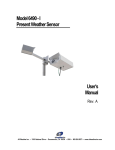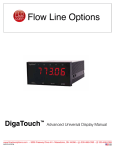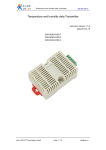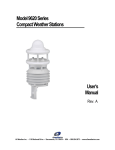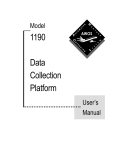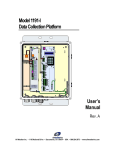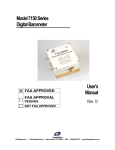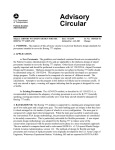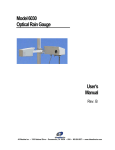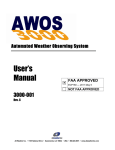Download User`s Manual Model 6500 Thunderstorm/Lightning
Transcript
Model 6500 Thunderstorm/Lightning Detector User’s Manual Rev. D All Weather Inc. • 1165 National Drive • Sacramento, CA 95834 • USA • 800.824.5873 • www.allweatherinc.com Copyright © 2011, All Weather, Inc. All Rights Reserved. The information contained herein is proprietary and is provided solely for the purpose of allowing customers to operate and/or service All Weather, Inc. manufactured equipment and is not to be released, reproduced, or used for any other purpose without written permission of All Weather, Inc. Throughout this manual, trademarked names might be used. Rather than put a trademark (™) symbol in every occurrence of a trademarked name, we state herein that we are using the names only in an editorial fashion and to the benefit of the trademark owner, and with no intention of infringement. All Weather, Inc. and the All Weather, Inc. logo are trademarks of All Weather, Inc. Disclaimer The information and specifications described in this manual are subject to change without notice. Latest Manual Version For the latest version of this manual, see the Product Manuals page under Reference on our web site at www.allweatherinc.com/. All Weather, Inc. 1165 National Drive Sacramento, CA 95834 Tel.: (916) 928-1000 Fax: (916) 928-1165 Contact Customer Service • Phone support is available from 8:00am - 4:30pm PT, Monday through Friday. Call 916-928-1000 and ask for “Service.” • Online support is available by filling out a request at www.allweatherinc.com/customer/support.html • E-mail your support request to [email protected] 6500 Thunderstorm/Lightning Detector User's Manual TABLE OF CONTENTS 1. OVERVIEW .........................................................................................................................1 1.1 Lightning Detection Antenna .................................................................................................... 1 1.2 Lightning Detection Data Processor .......................................................................................... 1 2. THEORY OF OPERATION .................................................................................................2 2.1 Lightning Detection ................................................................................................................... 2 2.2 Data Processing ......................................................................................................................... 2 2.3 Data Reporting........................................................................................................................... 2 3. DATA FORMAT...................................................................................................................4 3.1 Sensor Polling............................................................................................................................ 4 3.2 Sensor Output Format................................................................................................................ 4 3.2.1 Sensor Mode .................................................................................................................... 5 3.2.2 Strike Rate........................................................................................................................ 5 3.2.3 Lightning Description ...................................................................................................... 5 3.2.4 Lightning Location........................................................................................................... 6 3.2.5 Status Word...................................................................................................................... 6 3.2.6 Sensor Status .................................................................................................................... 6 3.2.7 Error Codes ...................................................................................................................... 7 3.2.8 Sensor Mode .................................................................................................................... 8 3.2.9 Noise Triggers .................................................................................................................. 8 3.2.10 Strike Test Rate ................................................................................................................ 8 3.2.11 Software Version ............................................................................................................. 8 3.2.12 Error Flag ......................................................................................................................... 8 3.2.13 Checksum ......................................................................................................................... 8 4. INSTALLATION & CHECKOUT ........................................................................................ 11 4.1 RFI/EMI Precautions ............................................................................................................... 11 4.2 Sensor Installation ................................................................................................................... 12 4.3 Checkout .................................................................................................................................. 15 5. DCP DISPLAY SCREENS ................................................................................................ 16 5.1 Data Screens ............................................................................................................................ 16 5.1.1 Lightning Sensor Pg. 1 ................................................................................................... 16 5.1.2 Lightning Sensor Pg. 2 ................................................................................................... 16 5.1.3 Lightning Sensor Pg. 3 ................................................................................................... 17 5.1.4 Lightning Sensor Pg. 4 ................................................................................................... 17 5.2 Status Screens .......................................................................................................................... 17 5.2.1 Lightning Sensor Pg. 5 ................................................................................................... 18 5.2.2 Lightning Sensor Pg. 6 and Pg. 7 ................................................................................... 18 5.2.3 Lightning Sensor Pg. 8 ................................................................................................... 18 6. ERROR MESSAGES AND TROUBLESHOOTING ........................................................... 19 6.1 Processor LEDs ....................................................................................................................... 22 6500 Thunderstorm/Lightning Detector User's Manual 7. MAINTENANCE................................................................................................................ 23 7.1 Periodic Maintenance Schedule .............................................................................................. 23 7.1.1 Monthly Maintenance ................................................................................................... 23 7.1.2 Triannual Maintenance .................................................................................................. 23 7.1.3 Annual Maintenance ..................................................................................................... 23 7.2 Maintenance Procedures ......................................................................................................... 23 7.2.1 Equipment Required ...................................................................................................... 23 8. SPECIFICATIONS ............................................................................................................ 24 9. WARRANTY ..................................................................................................................... 25 6500 Thunderstorm/Lightning Detector User's Manual 1. OVERVIEW The Model 6500 Thunderstorm/Lightning Detector detects electrical discharges associated with thunderstorms within a 200 nautical mile (nm) radius of the system. The Thunderstorm/Lightning Detector is a passive sensor that monitors electromagnetic signals with a receiving antenna. There is no transmitter, and so no harmful transmissions. The entire package (consisting of an antenna mounted to a 28" × 31" ground plane, and a processor and interface board housed in a NEMA 4X enclosure) mounts simply to a 2½" pipe (2.875" O.D.) using two U-bolts. 1.1 LIGHTNING DETECTION ANTENNA The Thunderstorm/Lightning Detector’s lightning detection antenna is a combined crossed-loop and sense antenna, which can correlate the electric and magnetic signatures of lightning strikes better than other systems because of its patented sense channel technology. The antenna has been designed to help filter out pulsed noise from sources other than lightning discharges. The antenna detects the electrical and magnetic fields generated by cloud-to-ground lightning, and sends the resulting “discharge signals” to the processor. 1.2 LIGHTNING DETECTION DATA PROCESSOR The Thunderstorm/Lightning Detector ‘s lightning detection processor houses the data acquisition circuitry, along with circuitry to process lightning strike data and communicate with the AWOS Data Collection Platform (DCP). Communication with the DCP is via an RS-485 link. The lightning detection processor digitizes, analyzes, and converts the discharge signals into range and bearing data, then stores the data in memory. The DCP polls the lightning detection sensor every two seconds via an RS-485 link. When polled, the sensor transmits a data package consisting of strike data and status information. When errors are detected, a command can be sent from the DCP requesting a complete error log from the sensor. This error log provides greater detail on the nature and severity of the error. 1 6500 Thunderstorm/Lightning Detector User's Manual 2. THEORY OF OPERATION 2.1 LIGHTNING DETECTION The Model 6500’s antenna is a combined crossed-loop and sense antenna, which can correlate the electric and magnetic signatures of lightning strikes better than other systems because of its patented sense channel technology. The antenna has been designed to help filter out pulsed noise from sources other than atmospheric electrical discharges. The antenna detects the electrical and magnetic fields generated by intra-cloud, inter-cloud, or cloudto-ground electrical discharges that occur within a 200 nautical mile radius of the antenna, and sends the resulting “discharge signals” to the processor. The processor digitizes, analyzes, and converts the discharge signals into range and bearing data, then stores the data in memory. 2.2 DATA PROCESSING The Model 6500’s processor is housed inside the sensor enclosure along with the Interface Board. The processor includes data acquisition circuitry and circuitry to process strike data. The Interface Board provides a data buffer and handles communication with the Data Collection Platform (DCP). The DCP polls the sensor every five seconds via an RS-485 link. When polled, the sensor transmits a data package consisting of strike data and status information. When errors are detected, the errors are recorded in an error log, and the most recent error is displayed on the lightning sensor status screen at the DCP (see Section 5.1). 2.3 DATA REPORTING The Model 6500 detects the presence of a lightning event within 200 nautical miles from the point of installation, and reports any of that activity occurring within a 30 nautical mile radius of the point of installation. The sensor detects and locates thunderstorms and provides the data as part of the standard AWOS message. 1. Range and Direction Reports thunderstorms/lightning within a 30 nautical mile radius from the installation point. Direction is expressed in compass octants for distances from 10 to 30 nautical miles. 2. Resolution The location of thunderstorm is reported to within ±1 nautical mile from actual location of the thunderstorm/ lightning detector. 3. Accuracy from Installation Point Within 10 nautical miles of installation: Detection: 90% of all thunderstorms Location: does not exceed 3 nautical miles Between 10 nautical miles and 30 nautical miles of installation: Detection: 80% of all thunderstorms Location: does not exceed 6 nautical miles 2 6500 Thunderstorm/Lightning Detector User's Manual 4. False Reports Not more than 2%. 5. Reporting Updates AWOS information once each minute. 3 6500 Thunderstorm/Lightning Detector User's Manual 3. DATA FORMAT The Model 6500 Thunderstorm/Lightning Detector interfaces to the DCP via the RS-485 network. RS-485 communication is set to 4800 bps, no parity, one stop bit. 3.1 SENSOR POLLING The DCP polls the Thunderstorm/Lightning Detector every five seconds using the DCP poll command shown below. LTNG00\r\n 3.2 SENSOR OUTPUT FORMAT The data received from the Thunderstorm/Lightning Detector are displayed on the DCP’s LCD display as they are received. The lightning data shown at the Central Display Platform (CDP) are updated once per minute. The sensor output is formatted as follows. =s rrrr ts/vsts ltg_dsnt status e crc <CR><LF> The data fields are space-delimited. The field values should be interpreted as follows. s rrrr ts/vsts ltg_dsnt status E CRC <CR> <LF> Sensor Mode The strike rate in counts per minute in normal mode Lightning Description Lightning Location Sensor operational status word Error Flag This provides a checksum value for data validation Carriage Return (hexadecimal value 0D) Line Feed (hexadecimal value 0A) The sample poll response below is a normal poll response when there is no lightning detected by the LTX sensor. =A 0 _ _ [email protected] 0 042C1 The sample poll response shown below is a sample poll response with 102 counts per minute of lightning reported from 5 to 10 nautical miles away in the Northeast, Southeast, South, Southwest, and Northwest quadrants. Table 1 explains each of the fields, which are identified in the poll response and in the table headings using color coding. =A 102 VCTS LTG_DSNT_NE_SE_S_SW_NW [email protected] ] 0A380 4 6500 Thunderstorm/Lightning Detector User's Manual Table 1. Sensor Output Field Descriptions Sensor Mode A E Normal Self-Test Strike Rate counts/min LTX Description LTX Location _ None (> 10 miles) TS Thunderstorm (< 5 n miles) VCTS Very Close Thunderstorm (5–10 n miles) LTG_DSNT Distant Lightning (10–30 n miles) 3.2.1 Sensor Mode = _ NE E SE S SW W NW N ALQDS None Northeast East Southeast South Southwest West Northwest North All Quadrants Status Error Flag Checksum See Error Codes Indicates if there has been an error CRC16 checksum; see Checksum A 102 VCTS LTG_DSNT_NE_SE_S_SW_NW [email protected] ] 0A380 For normal sensor operation, the sensor should always be reporting an A for the mode. The sensor should not be operating in any other mode. 3.2.2 Strike Rate =A 102 VCTS LTG_DSNT_NE_SE_S_SW_NW [email protected] ] 0A380 This is the number of lightning strikes detected within the full 200 nautical mile radius of the sensor during the previous one minute. The example shows the sensor reporting 102 lightning strikes during that 1-minute period. 3.2.3 Lightning Description =A 0 _ [email protected] 0 042C1 The lightning description indicates the distance of the lightning strikes that have been detected. The underscore “_” is used to show that there were no lightning strikes within 10 miles of the sensor. This is shown in the first example. If the lightning strikes are within 5 nautical miles of the sensor, TS is indicated in this location of the poll response. This means that there is a thunderstorm at the sensor location. =A 102 VCTS LTG_DSNT_NE_SE_S_SW_NW [email protected] ] If the lightning strikes are from 5 to 10 nautical miles from the sensor, VCTS is indicated in this location of the poll response. This reports that there is a thunderstorm in the vicinity of the LTX sensor. This is demonstrated in the example poll response. =A 102 VCTS LTG_DSNT_NE_SE_S_SW_NW [email protected] ] If the lightning strikes are from 10 to 30 nautical miles from the sensor LTG_DSNT is indicated in this location of the poll response. This is showing that there is lightning distant from the sensor, but still detectable as lightning. 5 6500 Thunderstorm/Lightning Detector User's Manual 3.2.4 Lightning Location =A 102 VCTS LTG_DSNT_ NE_SE_S_SW_NW [email protected] ] This field indicates the location of the detected lightning strikes. T he normal cardinal points with their standard abbreviations (N for North, SE for Southeast, etc.) are used in this location of the poll response. If there are lightning strikes detected at multiple directions, they will each be listed with an underscore “_” separating them. T he example poll response shows lightning from the Northeast, Southeast, South, Southwest, and Northwest. 3.2.5 Status Word =A 102 VCTS LTG_DSNT_NE_SE_S_SW_NW [email protected] ] The sensor status is made up of 6 sections. The breakout of the status word is shown below. [email protected] Table 2 explains each of the fields, which are identified in the example and in the table headings using color coding. Also note that each section of the status word is preceded by an indicator letter (S for status, E for error codes, etc.). Table 2. Status Word Fields Status P OK R Recoverable error F Fatal error Error Code See Error Codes 3.2.6 Sensor Status Mode Config Heading Buffer Reset A Normal Operating Should be G Should be @ Normally X Normally R E Self-Test =A 102 VCTS LTG_DSNT_NE_SE_S_SW_NW Noise Triggers Number of triggers in Noise Mode Strike Test Rate Strike Test Mode result [email protected] Software Version Version of installed software ] 0A380 The first value in the status word is the sensor status. The sensor status is preceded by a S. The sensor status value is a P for normal operation. If there has been an error and the sensor recovered from that error, the status is R. If the sensor has had an error that it cannot recover from, the status is F. 6 6500 Thunderstorm/Lightning Detector 3.2.7 Error Codes User's Manual [email protected] =A 102 VCTS LTG_DSNT_NE_SE_S_SW_NW SP 0A380 ] The error codes are represented by two numerical digits preceded by an E. The following table shows all the error codes with their probable causes. Table 3. Error Codes and Probable Causes Number Error Probable Cause 00 No Error Normal Operation 01 Processor Fault Main processor 05–08 Processor Fault Main processor memory 09–12 Processor Fault DSP processor memory 14, 15 Processor Fault DSP processor 16 Antenna Fault Antenna or antenna wiring 17 Processor Fault No test strikes, antenna in noisy location, or faulty antenna 18 Processor Fault Invalid test strikes, antenna in noisy location, or faulty antenna 19 Processor Fault Main Processor or Antenna in noisy location 20 Configuration Changed Antenna location (top/bottom, determined by processor wiring) changed since system was last powered up. 21 Processor Fault Main processor 22 Invalid XYZ Input N/A 23 Invalid Heading Reference N/A 24 MIC Key Stuck Mic key (inhibit line) has been asserted for at least 60 seconds 25–34 Processor Fault Main processor 35 Processor Fault Main or DSP processor 36 Processor Fault Main or DSP processor 40 Processor Fault Main processor 41 Processor Fault Main or DSP processor 42 Processor Fault Main processor 43 Invalid request Poll command was not received properly Serial Communication General communication errors including wrong baud rate, excessive noise, etc. 44–49 7 6500 Thunderstorm/Lightning Detector 3.2.8 Sensor Mode User's Manual [email protected] =A 102 VCTS LTG_DSNT_NE_SE_S_SW_NW SPE00 ] The sensor mode is preceded by an M. There are five parts to the sensor mode section of the status word. The first digit represents the sensor mode. This should always be an A for normal operation. The test mode is not used. The second digit is the sensor configuration. This should always be a G. The third digit is the sensor heading flag. This should always be a @. The forth digit is the buffer flag. This is a B if the buffer has been cleared and an X if the clear message has not been received. The fifth digit is the reset flag. This can either be an X or a R. 3.2.9 Noise Triggers N00000R0000VB1.03 =A 102 VCTS LTG_DSNT_NE_SE_S_SW_NW SPE00MAG@XR ] 0A380 The noise trigger count is preceded by an N. The noise trigger section of the status word is for the number of triggers detected when noise mode is on. This is a five digit number that should always be 00000 while the sensor is in normal operation. 3.2.10 Strike Test Rate =A 102 VCTS LTG_DSNT_NE_SE_S_SW_NW SPE00MAG@XRN00000 R0000VB1.03 ] The strike test rate is preceded by an R. The four digit number in the strike test rate section of the status word is the number of strikes detected per minute while the sensor is in the Strike Test mode. While the sensor is in normal operation, this should be 0000. 3.2.11 Software Version =A 102 VCTS LTG_DSNT_NE_SE_S_SW_NW SPE00MAG@XRN00000R0000 VB1.03 ] The software version of the sensor is preceded by a V. In the example shown the software version is B1.03. There are two separate software programs in the sensor. The second is in the serial interface board inside the sensor. The second software version is not displayed in the poll response. 3.2.12 Error Flag =A 102 VCTS LTG_DSNT_NE_SE_S_SW_NW [email protected] ] 0A380 This is only a status indicator that there was an error. This will normally be a 0. Any other character than a 0 indicates that an error has occurred. Refer to the error section of the status word for the actual error that occurred. 3.2.13 Checksum =A 102 VCTS LTG_DSNT_NE_SE_S_SW_NW [email protected] ] 0 A380 The last four text digits of the poll response is the checksum of the poll response. This allows the polling computer to verify that the data message was received properly. The checksum is calculated using the CRC16 method. A sample C program for calculating this CRC is shown below. 8 6500 Thunderstorm/Lightning Detector User's Manual /*************************************************************** CRC routine USE: crc = crc16(buffer, length, initial_value) where: crc is the returned value, buffer is the data buffer to compute a crc length is the number of bytes in buffer to process initial_value is the results of previous crc calculations that will allow the buffer crc to be computed in stages if necessary. If this is not necessary, then set initial_value to 0. ******************************************************************/ unsigned int crc16(char *string, unsigned int length, unsigned int ival) /* buffer address to compute a crc */ /* number of characters to process */ /* initial value of crc */ { static unsigned int crc; /* CRC values for crc16 routine */ static unsigned int crc_vals[] = { 0x0000,0xc0c1,0xc181,0x0140,0xc301,0x03c0,0x0280,0xc241, 0xc601,0x06c0,0x0780,0xc741,0x0500,0xc5c1,0xc481,0x0440, 0xcc01,0x0cc0,0x0d80,0xcd41,0x0f00,0xcfc1,0xce81,0x0e40, 0x0a00,0xcac1,0xcb81,0x0b40,0xc901,0x09c0,0x0880,0xc841, 0xd801,0x18c0,0x1980,0xd941,0x1b00,0xdbc1,0xda81,0x1a40, 0x1e00,0xdec1,0xdf81,0x1f40,0xdd01,0x1dc0,0x1c80,0xdc41, 0x1400,0xd4c1,0xd581,0x1540,0xd701,0x17c0,0x1680,0xd641, 0xd201,0x12c0,0x1380,0xd341,0x1100,0xd1c1,0xd081,0x1040, 0xf001,0x30c0,0x3180,0xf141,0x3300,0xf3c1,0xf281,0x3240, 0x3600,0xf6c1,0xf781,0x3740,0xf501,0x35c0,0x3480,0xf441, 0x3c00,0xfcc1,0xfd81,0x3d40,0xff01,0x3fc0,0x3e80,0xfe41, 0xfa01,0x3ac0,0x3b80,0xfb41,0x3900,0xf9c1,0xf881,0x3840, 0x2800,0xe8c1,0xe981,0x2940,0xeb01,0x2bc0,0x2a80,0xea41, 0xee01,0x2ec0,0x2f80,0xef41,0x2d00,0xedc1,0xec81,0x2c40, 0xe401,0x24c0,0x2580,0xe541,0x2700,0xe7c1,0xe681,0x2640, 0x2200,0xe2c1,0xe381,0x2340,0xe101,0x21c0,0x2080,0xe041, 0xa001,0x60c0,0x6180,0xa141,0x6300,0xa3c1,0xa281,0x6240, 0x6600,0xa6c1,0xa781,0x6740,0xa501,0x65c0,0x6480,0xa441, 0x6c00,0xacc1,0xad81,0x6d40,0xaf01,0x6fc0,0x6e80,0xae41, 0xaa01,0x6ac0,0x6b80,0xab41,0x6900,0xa9c1,0xa881,0x6840, 0x7800,0xb8c1,0xb981,0x7940,0xbb01,0x7bc0,0x7a80,0xba41, 0xbe01,0x7ec0,0x7f80,0xbf41,0x7d00,0xbdc1,0xbc81,0x7c40, 0xb401,0x74c0,0x7580,0xb541,0x7700,0xb7c1,0xb681,0x7640, 0x7200,0xb2c1,0xb381,0x7340,0xb101,0x71c0,0x7080,0xb041, 0x5000,0x90c1,0x9181,0x5140,0x9301,0x53c0,0x5280,0x9241, 0x9601,0x56c0,0x5780,0x9741,0x5500,0x95c1,0x9481,0x5440, 0x9c01,0x5cc0,0x5d80,0x9d41,0x5f00,0x9fc1,0x9e81,0x5e40, 0x5a00,0x9ac1,0x9b81,0x5b40,0x9901,0x59c0,0x5880,0x9841, 9 6500 Thunderstorm/Lightning Detector User's Manual 0x8801,0x48c0,0x4980,0x8941,0x4b00,0x8bc1,0x8a81,0x4a40, 0x4e00,0x8ec1,0x8f81,0x4f40,0x8d01,0x4dc0,0x4c80,0x8c41, 0x4400,0x84c1,0x8581,0x4540,0x8701,0x47c0,0x4680,0x8641, 0x8201,0x42c0,0x4380,0x8341,0x4100,0x81c1,0x8081,0x4040}; crc = ival; while(length--) crc = crc_vals[(*string++ ^ crc) & 0xff] ^ ((crc >> 8) & 0xff); return crc; } /* end crc16 routine */ 10 6500 Thunderstorm/Lightning Detector User's Manual 4. INSTALLATION & CHECKOUT NOTE Installation and checkout of the Model 6500 Thunderstorm/ Lightning Detector may only be performed by qualified personnel trained in the theory of operation of the Model 6500 Thunderstorm/Lightning Detector, site preparation requirements, maintenance theory of the Automated Weather Observing System (AWOS), and interface and operation functions of the AWOS Data Collection Platform. The Thunderstorm/Lightning Detector package (consisting of an antenna mounted to a 28" x 32" ground plane and a processor housed in a NEMA 4X enclosure) mounts to a 2½" pipe (2.875" O.D.) using two U-bolts. A section of 2.5" (64 mm) I.D. standard galvanized steel pipe can be used as a mast with no drawbacks or special adaptation. Refer to the site preparation instructions and applicable drawings for foundation, grounding, conduit, and junction box installation details. C AUT ION T he T hunders torm/L ightning Detec tor’s ground plane extends well beyond the edges of the s ens or enc los ure. B e aware of this hazard when working around the s ens or. 4.1 RFI/EMI PRECAUTIONS The Model 6500 Thunderstorm/ Lightning Detector’s antenna is sensitive to static charges, so care must be taken to ensure that the antenna and ground plane are as far removed as possible from composite materials (e.g., plastic materials or fiberglass), since these materials have a tendency to build up a static charge. The sensor should be mounted as far as possible from devices that emit high levels of radio-frequency interference (RFI) and electromagnetic interference (EMI), such as VHF and UHF radios, RF modems, fluorescent lamps, and ballasts, air conditioner and heater blowers, as well as any current-carrying cables. Pay attention to these general clearance guidelines. • • • • • • Strobe lamps and power supplies — 5 ft. (1.5 m) Fluorescent lamps and ballasts — 5 ft. (1.5 m) Air conditioners and heater blowers — 5 ft. (1.5 m) Telephone antennas — 4 ft. (1.2 m) VHF communication antennas — 1 ft. (0.3 m) Any current-carrying cable — 2 ft. (0.6 m) In addition to the above restrictions, certain site installations may have to be scrutinized more carefully from an RFI/EMI perspective. Finding locations to mount the ground plane and antenna that will minimize interference from RFI/EMI sources can be enhanced by the use of standard RFI measuring equipment. The recommended equipment for monitoring the proposed installation area is a typical spectrum analyzer with a broadband conical antenna. The spectrum analyzer should be set up to scan 11 6500 Thunderstorm/Lightning Detector User's Manual the frequencies of concern (100-500 MHz) for the typical VHF and UHF radio links near the installation. Once it has been determined that there is significant interference, it is imperative that the lightning sensor be moved to a location as far from the interfering device as possible. Under no circumstances should the lightning sensor antenna and ground plane be placed within one foot of either a VHF or UHF transmitting antenna. 4.2 SENSOR INSTALLATION After installing the mast, conduit, and junction box, follow the instructions below for assembling and installing the sensor. 1. If the signal and power cables have not already been installed between the signal and power distribution boxes and the sensor pad, pull the required lengths of cable through conduit to the junction boxes at the sensor pad. 2. (See Figure 1). The mounting bracket attaches to the underside of the 6500 enclosure with four bolts. Position the bracket against the underside of the enclosure so that the mounting holes in the bracket and enclosure align. Figure 1. Mounting Bracket Installation 3. Apply RTV 162 to the threads of the four 5/16" hex mounting bolts. 4. Fasten the bracket to the enclosure with the four 5/16" hex bolts, flat washers, and lock washers. 5. Tighten the bolts. 6. Set the sensor package (antenna, ground plane, enclosure, and bracket) on the mast, and fasten loosely with two U-bolts, lock washers, and flat washers as shown in Figure 2. 12 6500 Thunderstorm/Lightning Detector User's Manual Figure 2. Sensor Package Mounting 7. Align the antenna to magnetic north by holding a straightedge compass against the ground plane (with the compass's North index oriented in the same direction as the N on the ground plane) and turning the entire sensor package until the compass indicates North. 8. Tighten the two U-bolts. 9. Open the sensor enclosure by loosening the four countersunk bolts shown in Figure 3. Do not remove the six bolts holding the ground plane to the enclosure lid. Figure 3. Opening the Sensor Enclosure 10. The sensor enclosure lid is equipped with hinged bolts (see Figure 4) to allow the box to be opened with the ground plane attached. Grasp both sides of the ground plane and lift straight up as far as possible (about 3"), then tilt the ground plane and lid over carefully to gain access to the enclosure interior. When fully open, the ground plane will rest against the side of the enclosure. 13 6500 Thunderstorm/Lightning Detector User's Manual Figure 4. Enclosure Hinges 11. Route the signal and power cables from their junction boxes through flex conduit to the sensor. 12. Connect the signal wires to the interface board inside the enclosure (Figure 5) according to Table 4. 13. Connect the incoming AC power wires to the AC interface board inside the enclosure (Figure 5) according to Table 4. 14. Close the enclosure lid and tighten the four countersunk bolts. 15. Fasten a ground wire between the ground cable installed during site preparation and the ground clamp on the underside of the enclosure (see Figure 1). Figure 5. Interface Board 14 6500 Thunderstorm/Lightning Detector User's Manual Table 4. Lightning Detector Signal and Power Wiring Interface Board TB1 Pin Function Color DCP TB4 Pin 4 RS485 (+) WHITE 1 5 RS485 (-) BLACK 2 6 GROUND RED 7 AC Interface Board TB1 Pin Function Color 1 HOT BLACK 2 NEUTRAL WHITE 3 GROUND GREEN TB4 Interface Board TB1 7 (GND) 7 RED 6 5 DCP BLACK 4 WHITE 2 (RS485 (-)) 3 1 (RS485 (+)) 2 1 AC Interface Board TB1 1 HOT (BLACK) 2 NEUT (WHITE) 3 GND (GREEN) AC POWER 4.3 CHECKOUT To verify the sensor is working properly, power the sensor and DCP up and verify that, after one minute of operation, data is reported from the sensor. (Bear in mind that, in the absence of lightning in the measuring area, the data screens will report no strikes.) Check the status screens (described in the next section) and verify that no errors are reported. 15 6500 Thunderstorm/Lightning Detector User's Manual 5. DCP DISPLAY SCREENS The lightning data generated by the Model 6500 Thunderstorm/Lightning Detector is available for viewing on the DCP’s LCD display. These data are updated once per minute, and are shown on four consecutive data screens immediately following the ADC Vref screen (Screen 27). Four status screens follow the data screens. To view the data and status screens, scroll to the first lightning data screen using the * and # keys on the keypad as explained in the DCP User's Manual (to move down (to a higher numbered screen), press the # key. To move up (to a lower numbered screen), press the * key). The contents of the screens are explained below. If the sensor is not working, offline, or not communicating with the DCP, the message "Sensor Not Reporting" will be displayed on the first five screens (Pages 1–5), and "MMMMMMMMMMMMMM" will be shown on the following two screens (Pages 6 and 7). 5.1 DATA SCREENS Four separate screens report lightning data. The first three screens show strikes detected within different distance ranges (<10 nautical miles, 10–20 nautical miles, and >20 nautical miles). When a strike is detected, the data screens will show the direction of the strike by octant (N, S, NW, SE, etc.). When strikes are detected in several directions, they will all be shown, separated from one another by underscores. The fourth data screen shows the strike rate in number of strikes per minute. 5.1.1 Lightning Sensor Pg. 1 The first data screen reports any detected lightning strikes within 10 nautical miles of the installation site. If the strikes are within 0–5 nautical miles, the direction will be preceded by “TS” (thunderstorm). This will be voiced in the AWOS voice output as “Thunderstorm at the airport.” If the strikes are within 5–10 nautical miles, the direction will be preceded by “VCTS” (very close thunderstorm). This will be voiced in the AWOS voice output as “Thunderstorm in the vicinity.” If no strikes are detected, the message “No Strikes < 10 mi” will be displayed. This screen is updated every minute. Lightning VCTS_E_SE_S Sensor Pg1 This example indicates strikes have been detected between 5–10 nautical miles of the installation site to the East, Southeast, and South. 5.1.2 Lightning Sensor Pg. 2 The second data screen reports any detected lightning strikes between 10–30 nautical miles of the installation site. This will be voiced in the AWOS voice output as “Lightning distant,” followed by the direction of the strikes. 16 6500 Thunderstorm/Lightning Detector User's Manual If no strikes are detected, the message "No Strikes > 10 mi" will be displayed. If the data string exceeds the LCD’s capacity (20 characters), the data will be continued on the next screen (Lightning Sensor Pg. 3). This screen is updated every minute. Lightning LTG_DSNT_S Sensor Pg2 This example indicates strikes have been detected between 10-30 miles of the installation site to the South. 5.1.3 Lightning Sensor Pg. 3 The third data screen displays data continued from the previous screen when the amount of data for the 10-30 mile range exceeds the LCD's 20-character capacity. If the data does not exceed 20 characters, this screen is a duplicate of Lightning Sensor Pg. 2. Lightning LTG_DSNT_S Sensor Pg3 This example shows the same data as the preceding screen, since the current data for the 10-30 mile range does not exceed the LCD's capacity. 5.1.4 Lightning Sensor Pg. 4 The fourth data screen reports the number of strikes detected within the full measuring area (200 nautical mile radius of the installation site) during the previous one minute. The value is reported in strikes per minute. If no strikes were detected, the message “Strike Rate none” will be displayed. This screen is updated every minute. Lightning Strike Rate 15/min Sensor Pg4 This example indicates 15 lightning strikes were detected within the measuring area during the previous minute. 5.2 STATUS SCREENS Four status screens follow the four lightning data screens. The first status screen shows the sensor's current operating mode. The next two screens display the two most recent errors detected by the sensor's self-tests. The final screen shows CRC errors and timeouts detected since power-up. 17 6500 Thunderstorm/Lightning Detector User's Manual 5.2.1 Lightning Sensor Pg. 5 This screen shows the current operating mode of the sensor. This should always read "Normal Weather Data", unless the sensor fails or is disconnected, in which case it will read "Sensor Not Reporting". Lightning Sensor Normal Weather Data Pg5 5.2.2 Lightning Sensor Pg. 6 and Pg. 7 These two screens show the most recent status message received from the lightning sensor. The format of the status message is explained in Error! Reference source not found., and the error codes (indicated by the two-digit number immediately following "E") are listed in Table 5. Due to the length of the message, it is split between two screens. Lightning Sensor SPE00MAG@XXN00000 Pg6 Lightning R0000VB1.03 Pg7 Sensor The example shown above is decoded as follows. SP E00 MA G @ XX N00000 R0000 VB1.03 Sensor status=OK No errors Normal Weather Data mode Configuration=normal Heading flag=normal No clear message received from CDP; no reset Noise mode OFF Strike test mode OFF Software version B1.03 5.2.3 Lightning Sensor Pg. 8 The final lightning sensor status screen shows the number of CRC errors and timeouts detected since the sensor was powered up. LTNG00 0/ 0 CRC Err/Touts The above example shows that no CRC errors and no timeouts have been recorded since the sensor was last powered up. 18 6500 Thunderstorm/Lightning Detector User's Manual 6. ERROR MESSAGES AND TROUBLESHOOTING The Model 6500 continuously runs a series of self-tests to check sensor operation and returns error messages when a fault is detected. The most recent status message is displayed on two status screens viewable at the DCP (Lightning Sensor Pg. 6 and Lightning Sensor Pg. 7), as explained above. Any detected errors are identified by "E" and a two-digit number ("E00" during normal operation) on the first status screen. Table 5 lists all the possible error codes, along with the probable cause of the fault and possible corrective action. In many cases, a persistent error will require returning the sensor to All Weather Inc. for service. For monitoring communications between the DCP and the sensor, a third status screen (Lightning Sensor Pg. 8) displays a record of communications errors since the sensor was powered up. Table 5. Model 6500 Thunderstorm/Lightning Detector Error Codes ERROR PROBABLE CAUSE CORRECTIVE ACTION ERROR 01. Processor Fault. Main processor Continued operation is not possible. Contact Field Service. ERROR 05. Processor Fault. Main processor memory Continued operation is not possible. Contact Field Service. ERROR 06. Processor Fault. Main processor memory Continued operation is not possible. Contact Field Service. ERROR 07. Processor Fault. Main processor memory Continued operation is not possible. Contact Field Service. ERROR 08. Processor Fault. Main processor memory Continued operation is not possible. Contact Field Service. ERROR 09. Processor Fault. DSP processor memory Continued operation is not possible. Contact Field Service. ERROR 10. Processor Fault. DSP processor memory Continued operation is not possible. Contact Field Service. ERROR 11. Processor Fault. DSP processor memory Continued operation is not possible. Contact Field Service. ERROR 12. Processor Fault. DSP processor memory Continued operation is not possible. Contact Field Service. ERROR 14. Processor Fault. DSP processor Continued operation is not possible. Contact Field Service. ERROR 15. Processor Fault. DSP processor Continued operation is not possible. Contact Field Service. ERROR 16. Antenna Fault. Antenna or antenna wiring Weather mapping is inhibited. a. Check antenna wiring for opens and shorts. b. Contact Field Service. 19 6500 Thunderstorm/Lightning Detector User's Manual Table 5. Model 6500 Thunderstorm/Lightning Detector Error Codes ERROR PROBABLE CAUSE CORRECTIVE ACTION ERROR 17. Processor Fault. No test strikes, antenna in noisy location, or faulty antenna Weather mapping is inhibited. a. Check antenna wiring for opens and shorts. b. Fault will clear automatically if interference subsides. c. Contact Field Service. ERROR 18. Processor Fault. Invalid test strikes, antenna in noisy location, or faulty antenna Weather mapping is inhibited. a. Check antenna wiring for opens and shorts. b. Fault will clear automatically if interference subsides. c. Contact Field Service. ERROR 19. Processor Fault. Main Processor or Antenna in noisy location Weather mapping is inhibited. a. Fault will clear automatically if interference subsides. b. Contact Field Service. ERROR 20. Configuration Changed. Antenna location (top/bottom, determined by processor wiring) changed since system was last powered up. This may occur the first time the system is powered on in a new installation. Power the sensor off and back on again. If the error persists, contact Field Service. ERROR 21. Processor Fault. Main processor Continued operation is not possible. Contact Field Service. ERROR 22. Invalid XYZ Input. n/a n/a ERROR 23. Invalid Heading Ref. n/a n/a ERROR 24. MIC KEY STUCK. Mic key (inhibit line) has been asserted for at least 60 seconds Weather mapping is inhibited. a. Contact Field Service. ERROR 25 - 34. Processor Fault. Main processor Continued operation is not possible. Contact Field Service. ERROR 35. Processor Fault. Main or DSP processor Continued operation is not possible. Contact Field Service. ERROR 36. Processor Fault. Main or DSP processor Continued operation is not possible. Contact Field Service. ERROR 40. Processor Fault. Main processor Continued operation is not possible. Contact Field Service. ERROR 41. Processor Fault. Main or DSP processor Continued operation is not possible. Contact Field Service. ERROR 42. Processor Fault. Main processor Continued operation is not possible. Contact Field Service. 20 6500 Thunderstorm/Lightning Detector User's Manual Table 5. Model 6500 Thunderstorm/Lightning Detector Error Codes ERROR PROBABLE CAUSE CORRECTIVE ACTION ERROR 43. Invalid request. DCP Message error will clear once processed a. Excessive noise on communication lines, check wiring. b. If error occurs frequently, contact Field Service ERROR 44 - 49. Serial Communication. DCP Message error will clear once processed a. Improper baud rate from DCP. b. Excessive noise on communication lines, check wiring. c. If error occurs frequently, contact Field Service. ERROR 50. Illegal Serial Heading Value. DCP Message error will clear once processed a. Excessive noise on communication lines, check wiring. b. If error occurs frequently, contact Field Service. ERROR 51. Invalid Message. DCP Message error will clear once processed a. Excessive noise on communication lines, check wiring. b. If error occurs frequently, contact Field Service. ERROR 52. Invalid Antenna Change Request. DCP Message error will clear once processed a. A request was received to change the antenna mount to a location that does not match the configuration jumpers. Request is ignored. b. If error occurs frequently, contact Field Service. ERROR 53 - 54. Communications Buffer Overload. DCP Message error will clear once processed a. Excessive noise on communication lines, check wiring. b. If error occurs frequently, contact Field Service. 21 6500 Thunderstorm/Lightning Detector User's Manual 6.1 PROCESSOR LEDS The processor (housed within the enclosure) is equipped with a series of LEDs on its front panel (see Figure 6) that can be used to monitor certain basic functions. Table 6 explains how to interpret the LEDs. Figure 6. Processor Front Panel LEDs Table 6. Processor LED Functions COMMUNICATION LED NORMAL OPERATION FAILED OPERATION DSP 1 ON OFF 6 Toggles ON/OFF when strike detected Does not toggle ON/OFF when strike detected 7 OFF ON 8 Toggles ON/OFF once per second Stays ON or OFF (does not toggle) TX Reserved for future use Reserved for future use RX Reserved for future use Reserved for future use TX ON (pulses when TX occurs) * Stays OFF or ON (does not pulse) RX ON (pulses when RX occurs) * Stays OFF or ON (does not pulse) MAIN SERIAL * Serial communication occurs every 2 seconds, causing LEDs to pulse rapidly. Due to transmission speed, LEDs may appear not to change conditions during TX/RX operation. 22 6500 Thunderstorm/Lightning Detector User's Manual 7. MAINTENANCE The routine maintenance described in this chapter must be performed according to the schedule presented in Section 7.1 using the maintenance procedures described in Section 7.2. 7.1 PERIODIC MAINTENANCE SCHEDULE Periodic maintenance procedures for the 7150 Series Digital Barometers are divided into three categories within the maintenance cycle — monthly, triannual, and annual maintenance. 7.1.1 Monthly Maintenance No monthly maintenance is required for this sensor. 7.1.2 Triannual Maintenance Perform the following maintenance tasks triannually: • Check the antenna for dents, cracks, or punctures. • Remove all dirt and grease from surface areas using a soft cloth moistened with mild soap and water. • Check the sealant around the antenna base and mounting bolts, and reapply as necessary (use RTV 162). • Check all hardware for corrosion and ensure that all bolts and connectors are tight. • Ensure that the cable connections are sound between the sensor and DCP. 7.1.3 Annual Maintenance • Perform the procedures outlined for triannual maintenance. 7.2 MAINTENANCE PROCEDURES 7.2.1 Equipment Required The following equipment is required for the Model 6500 Thunderstorm/Lightning Detector maintenance procedures. • RTV 162 (as necessary) 23 6500 Thunderstorm/Lightning Detector User's Manual 8. SPECIFICATIONS Parameter Specification 0 – 200 nautical miles (0 – 370 km) Measuring Range Operating Temperature -67 to +158ºF (-55 to +70ºC) Storage Temperature -103 to +158ºF (-75 to +70ºC) Humidity Noncondensing up to 100% Baud Rate Serial Port Parameter Setting 4800 bps 8-N-1 (8 data bits, no parity, 1 stop bit) Serial Connector RS-485 screw terminal block pins Supply Voltage 11–32 V DC Power Consumption Mounting Dimensions 11 W Head mounts to 2.5" pipe (2.875" O.D.) 27.5" W × 30.9" L × 9.0" D (700 mm × 790 mm × 230 mm) Weight 35 lb (16 kg) Shipping Weight 40 lb (18 kg) 24 6500 Thunderstorm/Lightning Detector User's Manual 9. WARRANTY Unless specified otherwise, All Weather Inc. (the Company) warrants its products to be free from defects in material and workmanship under normal use and service for one year from date of shipment, subject to the following conditions: (a) The obligation of the Company under this warranty is limited to repairing or replacing items or parts which have been returned to the Company and which upon examination are disclosed, to the Company’s satisfaction, to have been defective in material or workmanship at time of manufacture. (b) The claimant shall pay the cost of shipping any part or instrument to the Company. If the Company determines the part to be defective in material or workmanship, the Company shall prepay the cost of shipping the repaired instrument to the claimant. Under no circumstances will the Company reimburse claimant for cost incurred in removing and/or reinstalling replacement parts. (c) This warranty shall not apply to any Company products which have been subjected to misuse, negligence or accident. (d) This warranty and the Company’s obligation thereunder is in lieu of all other warranties, express or implied, including warranties of merchantability and fitness for a particular purpose, consequential damages and all other obligations or liabilities. No other person or organization is authorized to give any other warranty or to assume any additional obligation on the Company’s behalf, unless made in writing and signed by an authorized officer of the Company. 25 All Weather Inc. 1165 National Drive Sacramento, CA 95818 Fax: 916.928.1165 Phone: 916.928.1000 Toll Free: 800.824.5873 6500-001 Revision D February, 2011






























